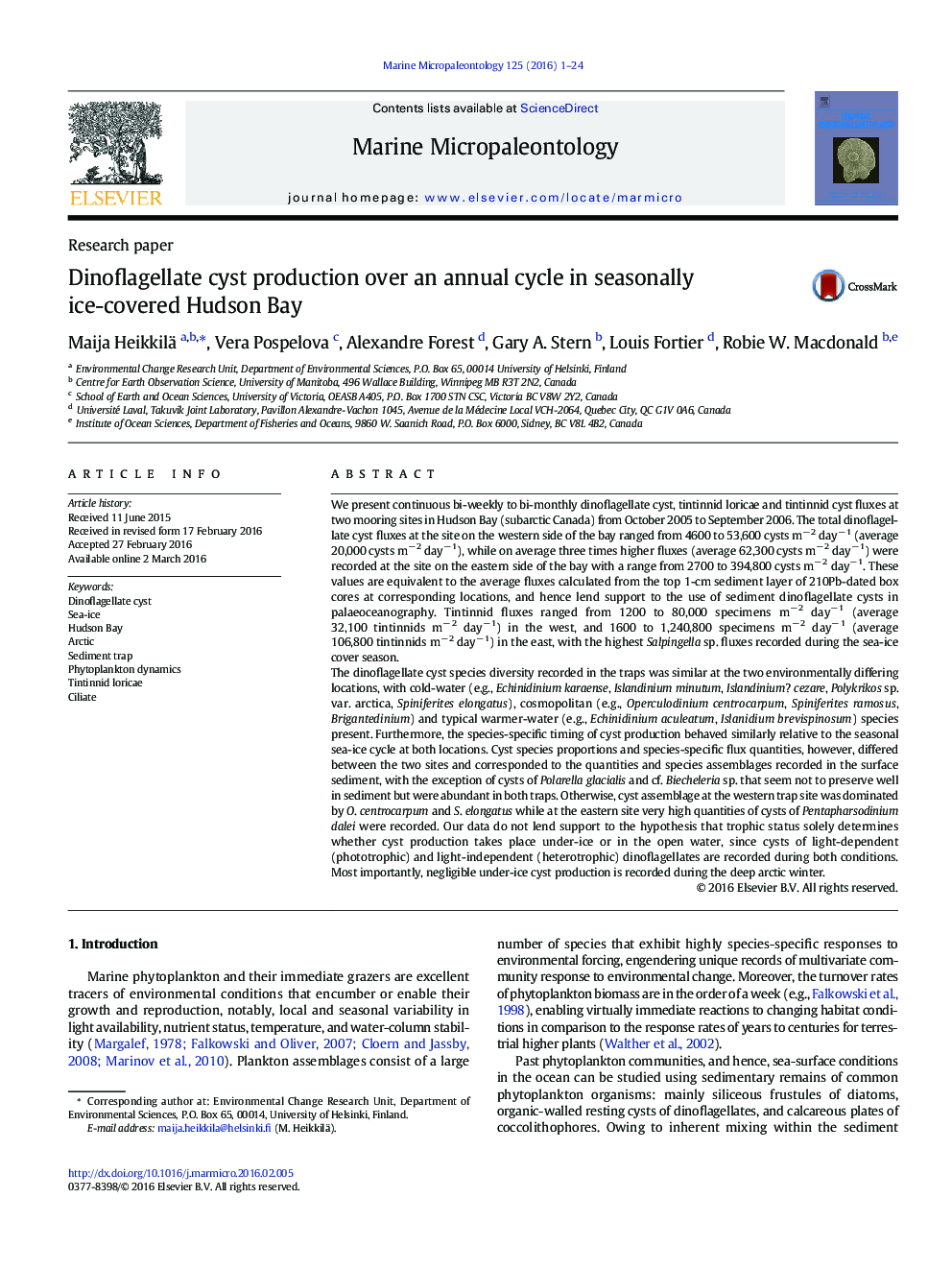| کد مقاله | کد نشریه | سال انتشار | مقاله انگلیسی | نسخه تمام متن |
|---|---|---|---|---|
| 4748765 | 1642160 | 2016 | 24 صفحه PDF | دانلود رایگان |
• First seasonal dataset of dinoflagellate cysts from a sea-ice-covered region.
• Flux quantities differ between the eastern and the western Hudson Bay.
• Flux quantities are equivalent to those measured from dated surface sediment.
• Species-specific timing of cyst production is linked to the sea-ice cycle.
• Trophic level does not define cyst production in open versus ice-covered water.
We present continuous bi-weekly to bi-monthly dinoflagellate cyst, tintinnid loricae and tintinnid cyst fluxes at two mooring sites in Hudson Bay (subarctic Canada) from October 2005 to September 2006. The total dinoflagellate cyst fluxes at the site on the western side of the bay ranged from 4600 to 53,600 cysts m− 2 day− 1 (average 20,000 cysts m− 2 day− 1), while on average three times higher fluxes (average 62,300 cysts m− 2 day− 1) were recorded at the site on the eastern side of the bay with a range from 2700 to 394,800 cysts m− 2 day− 1. These values are equivalent to the average fluxes calculated from the top 1-cm sediment layer of 210Pb-dated box cores at corresponding locations, and hence lend support to the use of sediment dinoflagellate cysts in palaeoceanography. Tintinnid fluxes ranged from 1200 to 80,000 specimens m− 2 day− 1 (average 32,100 tintinnids m− 2 day− 1) in the west, and 1600 to 1,240,800 specimens m− 2 day− 1 (average 106,800 tintinnids m− 2 day− 1) in the east, with the highest Salpingella sp. fluxes recorded during the sea-ice cover season.The dinoflagellate cyst species diversity recorded in the traps was similar at the two environmentally differing locations, with cold-water (e.g., Echinidinium karaense, Islandinium minutum, Islandinium? cezare, Polykrikos sp. var. arctica, Spiniferites elongatus), cosmopolitan (e.g., Operculodinium centrocarpum, Spiniferites ramosus, Brigantedinium) and typical warmer-water (e.g., Echinidinium aculeatum, Islanidium brevispinosum) species present. Furthermore, the species-specific timing of cyst production behaved similarly relative to the seasonal sea-ice cycle at both locations. Cyst species proportions and species-specific flux quantities, however, differed between the two sites and corresponded to the quantities and species assemblages recorded in the surface sediment, with the exception of cysts of Polarella glacialis and cf. Biecheleria sp. that seem not to preserve well in sediment but were abundant in both traps. Otherwise, cyst assemblage at the western trap site was dominated by O. centrocarpum and S. elongatus while at the eastern site very high quantities of cysts of Pentapharsodinium dalei were recorded. Our data do not lend support to the hypothesis that trophic status solely determines whether cyst production takes place under-ice or in the open water, since cysts of light-dependent (phototrophic) and light-independent (heterotrophic) dinoflagellates are recorded during both conditions. Most importantly, negligible under-ice cyst production is recorded during the deep arctic winter.
Journal: Marine Micropaleontology - Volume 125, May 2016, Pages 1–24
